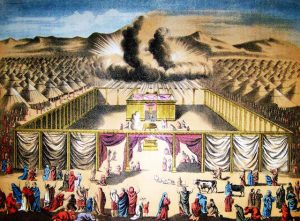What you are referring to is the Haftarah read on this Shabbos, the Shabbos immediately following Tisha B’av, from the Book of Isaiah (40:1-26), which commences with the famous prophetic phrase, “Be comforted, be comforted My people, says G-d!”
Isaiah, one of the leading prophets who foretold the destruction of the Temple and the subsequent exile of the Jewish people, exhorts the Nation to not give up hope. They need to know that despite the dismal times ahead there is destined to eventually be a better future.
Still, despite knowing there will be a bright future, it is quite difficult to be “comforted” while we are focused on, and surrounded by, utter darkness and destruction. It takes a lot more thought, trust and contemplation to achieve a level of comfort than it does to focus upon the impending destruction.
This is why we need seven weeks of consolation, more than double the three weeks established to focus upon the destruction itself.
We can take this a step deeper. The word “nachem” is usually translated as comfort or consolation. In fact, these translations are inaccurate; the literal meaning is to take a new look at the same set of circumstances and arrive at a different conclusion. It is a paradigm shift.
The Talmud relates the story of Rabbi Akiva and his colleagues observing the place where the Temple once stood, after its destruction. The Rabbis, upon seeing a fox emerging from the spot of the former Holy of Holies, burst out crying, while Rabbi Akiva laughed. Shocked, they inquired as to the reason for his laughter. He replied by asking them why they are crying. “Why are we crying?! This is the holiest spot in the world, where even the holiest Jew would not have permission to enter it besides the High Priest on Yom Kippur – and now a fox is walking there, why shouldn’t we cry?!”
Rabbi Akiva went on to show them that it was precisely that fox which is the cause of his laughter. This is the fulfillment of the prophecy of utter destruction, that Zion will be plowed over like a field, (Micah 3:12). That prophecy of destruction, however, leads to the following prophecy of the eventual redemption and rebuilding of the Temple, that elderly men and women will happily sit in the streets of Jerusalem, (Zecharia 8:4). Hence, to observe the beginning of the prophetic sequence towards the rebuilding of the Temple by seeing wild animals in the holy place, signifying its being plowed over like a field, is a reason for him to rejoice, not cry!
The Rabbis then exclaimed to Rabbi Akiva that he has brought them to nechama; to view this tragedy in a different light – though a new lens – that of the first step of redemption. This was a paradigm shift of the highest order. (Talmud, Makos 24b).
There are many examples which teach us how to look at the tragedy of the destruction of the Temple and exile through two lenses. There is the lens of the tragedy that it is. Concurrently, through the lens of the silver lining and the revelation of G-d behind the scenes even when He seems to be completely hidden. The second lens comforts us, with a new depth of perception as to the deep, unbroken connection between G-d and the Jewish People despite the separation.
We have endured a very painful exile over the past some 2000 years. There have been untold and unimaginable trials and tribulation and it is easy to lose hope. tYet the Al-mighty sends us signals from time to time. He is winking at us and letting us know that He is fully aware and engaged with us and with our destiny. He lets us know that whatever we are experiencing is the next big step in the Master Plan of history being led from Above. This is our nechama, our paradigm shift which leads to comfort and consolation.
This Shabbos and its Haftara invites us to join Rabbi Akiva and his colleagues and know that we are in Good Hands. This is our paradigm shift, our Nechama.
Sincerely,
Rabbi Yerachmiel Fried


